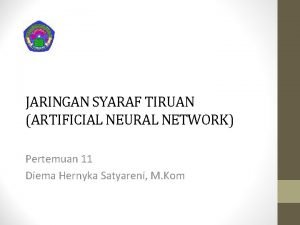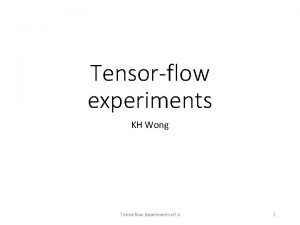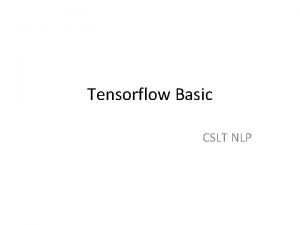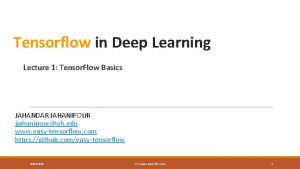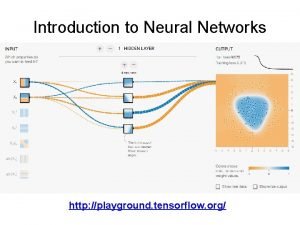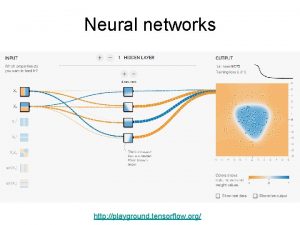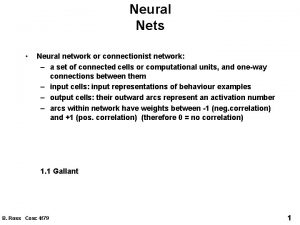Tensorflow in Deep Learning Lecture 2 Neural Network






















- Slides: 22

Tensorflow in Deep Learning Lecture 2: Neural Network JAHANDAR JAHANIPOUR jjahanipour@uh. edu www. easy-tensorflow. com https: //github. com/easy-tensorflow 30/04/2018 www. easy-tensorflow. com 1

Outline • Neural Network • • • Introduction to Neural Network Implementing a Neural Network in Tensor. Flow Tensor. Board • • 30/04/2018 Visualize the network graph Write summary www. easy-tensorflow. com 2

Neural Network Biological Neuron: The basic computational unit of the brain. Mathematical model

Activation Functions • nonlinearity: 30/04/2018 www. easy-tensorflow. com 4

Neural Network #parameters = 200 x 784 + 200 + 10 x 200 + 10 =159, 010 30/04/2018 www. easy-tensorflow. com 5

Neural Network b = tf. get_variable('bias', initializer=tf. zeros(200)) W = tf. get_variable('weight', shape=(784, 200), initializer=tf. truncated_normal_initializer(mean=0. 0, stddev=0. 01)) X = tf. placeholder(tf. float 32, shape=[None, 784], name='input') y = tf. placeholder(tf. float 32, shape=[None, 10], name='label') Why None? 30/04/2018 www. easy-tensorflow. com 6

Neural Network In each Iteration: ? x 784 (? = batch size) ? x 10 ? x 200 30/04/2018 www. easy-tensorflow. com ? x 10 7

Neural Network In each Iteration: 100 x 784 30/04/2018 (batch size = 100) 100 x 200 www. easy-tensorflow. com 100 x 10 8

Neural Network Test time: 10, 000 x 784 30/04/2018 (10, 000 test samples) 10, 000 x 200 www. easy-tensorflow. com 10, 000 x 10 9

Hyper-parameters # Data Dimensions img_h = img_w = 28 img_size_flat = img_h * img_w n_classes = 10 # Hyper-parameters learning_rate = 0. 001 epochs = 10 batch_size = 100 display_freq = 100 # # # MNIST images are 28 x 28 # 28 x 28=784, the total number of pixels # Number of classes, one class per digit The optimization initial learning rate Total number of training epochs Training batch size Frequency of displaying the training results variables # Network Configuration h 1 = 200 # Number of units in the first hidden layer 30/04/2018 www. easy-tensorflow. com 10

Build Graph # Placeholders for inputs (x), outputs(y) x = tf. placeholder(tf. float 32, shape=[None, img_size_flat], name='X') y = tf. placeholder(tf. float 32, shape=[None, n_classes], name='Y') # Hidden layer W 1 = tf. get_variable('W_1', dtype=tf. float 32, shape=[784, 200], initializer=tf. truncated_normal_initializer(stddev=0. 01)) b 1 = tf. get_variable('b_1', dtype=tf. float 32, initializer=tf. constant(0. , shape=[200], dtype=tf. float 32)) wxb = tf. matmul(x, W 1) + b 1 fc_1 = tf. nn. relu(wxb) # Output layer W 2 = tf. get_variable('W_2', dtype=tf. float 32, shape=[200, 10], initializer=tf. truncated_normal_initializer(stddev=0. 01)) b 2 = tf. get_variable('b_2', dtype=tf. float 32, initializer=tf. constant(0. , shape=[10], dtype=tf. float 32)) output_logits = tf. matmul(fc_1, W 2) + b 2 g m www. easy-tensorflow. com a gr o y z La 30/04/2018 m Pr 11 in

Build Graph # Create the network graph x = tf. placeholder(tf. float 32, shape=[None, img_size_flat], name='X') y = tf. placeholder(tf. float 32, shape=[None, n_classes], name='Y') fc 1 = fc_layer(x, h 1, 'FC 1', use_relu=True) output_logits = fc_layer(fc 1, n_classes, 'OUT', use_relu=False) 4] [ 78 ? , 0 20 def fc_layer(x, num_units, name, use_relu=True): 784 in_dim = x. get_shape()[1] 784, 200] W = weight_variable(name, shape=[in_dim, num_units]) [200] b = bias_variable(name, [num_units]) [? , 200] layer = tf. matmul(x, W) [? , 200] layer += b if use_relu: layer = tf. nn. relu(layer) [? , 200] return layer 30/04/2018 def weight_variable(name, shape): initer = tf. truncated_normal_initializer(stddev=0. 01) return tf. get_variable('W_' + name, dtype=tf. float 32, shape=shape, initializer=initer) def bias_variable(name, shape): initial = tf. constant(0. , shape=shape, dtype=tf. float 32) return tf. get_variable('b_' + name, dtype=tf. float 32, initializer=initial) www. easy-tensorflow. com 12

Create Optimization Operations # Define the loss function, optimizer, and accuracy loss = tf. reduce_mean(tf. nn. softmax_cross_entropy_with_logits(labels=y, logits=output_logits), name='loss') optimizer = tf. train. Adam. Optimizer(learning_rate=learning_rate, name='Adam-op'). minimize(loss) Adam-op correct_prediction = tf. equal(tf. argmax(output_logits, 1), tf. argmax(y, 1), name='correct_pred') accuracy = tf. reduce_mean(tf. cast(correct_prediction, tf. float 32), name='accuracy') loss # Network predictions cls_prediction = tf. argmax(output_logits, axis=1, name='predictions') # Initializing the variables init = tf. global_variables_initializer() accuracy correct_pred OUT fc 1 init 30/04/2018 www. easy-tensorflow. com Y X 13

Session # Launch the graph (session) with tf. Session() as sess: sess. run(init) # Number of training iterations in each epoch num_tr_iter = int(mnist. train. num_examples / batch_size) for epoch in range(epochs): print('Training epoch: {}'. format(epoch+1)) for iteration in range(num_tr_iter): batch_x, batch_y = mnist. train. next_batch(batch_size) # Run optimization op (backprop) feed_dict_batch = {x: batch_x, y: batch_y} sess. run(optimizer, feed_dict=feed_dict_batch) 30/04/2018 www. easy-tensorflow. com 14

Tensor. Board Tensorboard is a flashlight for our Neural Net's black box. 1. Visualize graph 2. Write summaries 3. Embedding Visualization 30/04/2018 www. easy-tensorflow. com 15

1. Visualize the graph • Write data from Tensor. Flow to disc ! # Launch the graph (session) with tf. Session() as sess: train_writer = tf. summary. File. Writer(logdir='logs', graph=sess. graph) • Then, in the command line type: >> tensorboard --logdir=logs Let’s clean up the graph ! • Name scope / Variable scope it ! n d Goo 30/04/2018 g atin t s r de www. easy-tensorflow. com ith u w k c lu 16

1. Visualize the graph with tf. name_scope("Input"): x = tf. placeholder(tf. float 32, shape=[None, img_size_flat], name='X') y = tf. placeholder(tf. float 32, shape=[None, n_classes], name='Y') fc 1 = fc_layer(x, h 1, 'FC 1', use_relu=True) output_logits = fc_layer(fc 1, n_classes, 'OUT', use_relu=False) with tf. name_scope("Train"): # Define the loss function, optimizer, and accuracy with tf. name_scope("Loss"): loss = tf. reduce_mean(tf. nn. softmax_cross_entropy_with_logits(labels=y, logits=output_logits), name='loss') with tf. name_scope("Optimizer"): optimizer = tf. train. Adam. Optimizer(learning_rate=learning_rate, name='Adam-op'). minimize(loss) with tf. name_scope("Accuracy"): correct_prediction = tf. equal(tf. argmax(output_logits, 1), tf. argmax(y, 1), name='correct_pred') accuracy = tf. reduce_mean(tf. cast(correct_prediction, tf. float 32), name='accuracy') with tf. name_scope("Prediction"): # Network predictions cls_prediction = tf. argmax(output_logits, axis=1, name='predictions') def fc_layer(x, num_units, name, use_relu=True): with tf. variable_scope(name): in_dim = x. get_shape()[1] W = weight_variable(name, shape=[in_dim, num_units]) b = bias_variable(name, [num_units]) layer = tf. matmul(x, W) layer += b if use_relu: layer = tf. nn. relu(layer) return layer 30/04/2018 www. easy-tensorflow. com 17

2. Write Summaries • tf. summary. scalar with tf. variable_scope('Train'): with tf. variable_scope('Loss'): loss = tf. reduce_mean(tf. nn. softmax_cross_entropy_with_logits(labels=y, logits=output_logits), name='loss') tf. summary. scalar('loss', loss) with tf. variable_scope('Optimizer'): optimizer = tf. train. Adam. Optimizer(learning_rate=learning_rate, name='Adam-op'). minimize(loss) with tf. variable_scope('Accuracy'): correct_prediction = tf. equal(tf. argmax(output_logits, 1), tf. argmax(y, 1), name='correct_pred') accuracy = tf. reduce_mean(tf. cast(correct_prediction, tf. float 32), name='accuracy') tf. summary. scalar('Accuracy', accuracy) with tf. variable_scope('Prediction'): # Network predictions cls_prediction = tf. argmax(output_logits, axis=1, name='predictions') 30/04/2018 www. easy-tensorflow. com 18

2. Write Summaries • tf. summary. image with tf. name_scope("Input"): x = tf. placeholder(tf. float 32, shape=[None, img_size_flat], name='X') tf. summary. image('input', tf. reshape(x, (-1, img_h, img_w, 1)), 3) y = tf. placeholder(tf. float 32, shape=[None, n_classes], name='Y') 30/04/2018 www. easy-tensorflow. com 19

2. Write Summaries • tf. summary. histogram def fc_layer(x, num_units, name, use_relu=True): with tf. variable_scope(name): in_dim = x. get_shape()[1] W = weight_variable(name, shape=[in_dim, num_units]) b = bias_variable(name, [num_units]) tf. summary. histogram('W', W) tf. summary. histogram('b', b) layer = tf. matmul(x, W) layer += b if use_relu: layer = tf. nn. relu(layer) return layer 30/04/2018 www. easy-tensorflow. com 20

2. Write Summaries • Lots of summary ops ! Do we have to run them individually? # Merge all summaries merged = tf. summary. merge_all() with tf. Session() as sess: train_writer = tf. summary. File. Writer( logdir='logs', graph=sess. graph) sess. run(init) # Number of training iterations in each epoch num_tr_iter = int(mnist. train. num_examples / batch_size) for epoch in range(epochs): for iteration in range(num_tr_iter): batch_x, batch_y = mnist. train. next_batch(batch_size) # Run optimization op (backprop) feed_dict_batch = {x: batch_x, y: batch_y} _, summary_tr = sess. run([optimizer, merged], feed_dict=feed_dict_batch) train_writer. add_summary(summary_tr, global_step) 30/04/2018 www. easy-tensorflow. com 21

2. Write Summaries • You can run your network with several hyper-parameters and save them in subfolders: ◦ Let’s change the hidden layer size and see how the parameters change ! From “logs” parent folder: >> tensorboard --logdir=logs 30/04/2018 www. easy-tensorflow. com 22
 Deep forest towards an alternative to deep neural networks
Deep forest towards an alternative to deep neural networks Graph neural network lecture
Graph neural network lecture Tensorflow lecture
Tensorflow lecture Adaptive learning neural network
Adaptive learning neural network Cmu machine learning
Cmu machine learning Deep learning approach and surface learning approach
Deep learning approach and surface learning approach Efficient processing of deep neural networks pdf
Efficient processing of deep neural networks pdf Deep neural networks and mixed integer linear optimization
Deep neural networks and mixed integer linear optimization 01:640:244 lecture notes - lecture 15: plat, idah, farad
01:640:244 lecture notes - lecture 15: plat, idah, farad Deep asleep deep asleep it lies
Deep asleep deep asleep it lies 深哉深哉耶穌的愛
深哉深哉耶穌的愛 Merzenich et al (1984) ib psychology
Merzenich et al (1984) ib psychology Least mean square algorithm in neural network
Least mean square algorithm in neural network Student teacher deep learning
Student teacher deep learning Cost function in neural network
Cost function in neural network Threshold logic unit in neural network
Threshold logic unit in neural network Meshnet: mesh neural network for 3d shape representation
Meshnet: mesh neural network for 3d shape representation Pengertian artificial neural network
Pengertian artificial neural network Neural network in r
Neural network in r Matlab neural network toolbox pdf
Matlab neural network toolbox pdf Spss neural network
Spss neural network Xkcd neural network
Xkcd neural network Extensions of recurrent neural network language model
Extensions of recurrent neural network language model

















